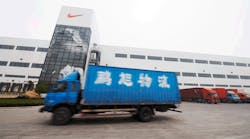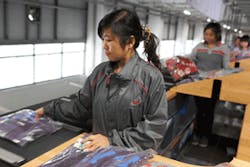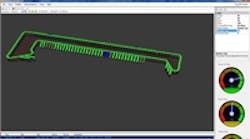How NIKE Made Two Million Square Feet of Distribution Sustainable
A two-million-square-foot distribution center can do a lot of things, but being environmentally sustainable would seem to be off that chart. However, NIKE’s new China Logistics Center (CLC) in Taicang, Jiangsu was designed to be a showcase of sustainability.
The CLC is the company’s largest distribution center in Asia. It handles all shipments of NIKE apparel and footwear for mainland China. With an extensive conveyor network, high-tech Crisplant sortation equipment and technologies such as voice picking, the facility is designed to operate more efficiently and accurately than a more traditional distribution center.
A large part of the energy consumed in a distribution center is used to run the sortation equipment and conveyors, so NIKE decided on cross-belt and tilt-tray sorters that use linear synchronous motor technology to reduce energy consumption by 75 percent compared with sorters using conventional technologies. These sorters (Crisplant’s LS-4000 and its software controls), are helping NIKE achieve a number of its core corporate goals: increased operational efficiency, shipping flexibility and accuracy, as well as reducing handling costs, energy consumption and the environmental impact of its operations.
Sortation Process
The sortation process starts with cartons being unloaded from trucks in the receiving area and then stacked on pallets. The pallets are then moved into the very narrow aisle (VNA) warehouse area.
As required, pallet loads of cartons are selected from the VNA racking and transferred onto a conveyor that merges the cartons onto a line sorter. The line sorter delivers the cartons to three possible destinations depending on whether the goods are to be shipped in batches or made up into new cartons containing a number of different items:
• Whole cartons for onward shipment are delivered to the shipping sorter
• Cartons with items ordered in whole-carton batches go to the pre-sorter induction area
• Cartons containing items that will be collated into mixed-item shipments are sent to the storage
Items unpacked from the cartons are placed into storage racks from which operators pick and place the individual items into plastic totes. The conveyor transports the totes, containing the individual items, to a conveyor on Level 2 of the building. These totes and whole cartons containing batches of the same item are then merged before being emptied and items are manually placed onto the cross-belt pre-sorter. This automatically sorts the items in the totes into pre-defined hoppers, which are emptied at the hopper tipping area, from where a system of belt conveyors transports them to manual inductions for loading onto the final sorter.
The final sorter is a second cross-belt, which automatically distributes the individual items into chutes that have been specially designed for the NIKE CLC to reduce the footprint of the sorting area. The chutes feature dividers that rise following the delivery of a complete batch, thereby separating it for packing into a single carton by the operator below. The carton is then pushed onto a roller conveyor for delivery to a Crisplant LS-4000E tilt-tray shipping sorter.
Sorters and controls
The sorter system and machinTo ensure uptime, NIKE entered into a three-year service agreement with Crisplant under which service engineers are stationed on-site for support and preventive maintenance of all material handling equipment, including management of the on-site spare-parts inventory. This arrangement enables the systems to be updated as new sorter technologies and software controls are introduced.
System At-a-Glance• Two LS-4000CB cross-belt sorters for pre-sort and final sort
• One LS-4000E tilt-tray sorter for shipping
• 75 percent saving in energy-consumption over conventional sorters
• Crisplant software controls for system-wide optimization. Crisplant’s system control is interfaced to NIKE’s WMS through a warehouse control system.
The sorting system is integrated with:
• Over 9km of conveyor, controlled by five Siemens S400 PLCs
• More than 90 datalogic barcode scanners
• Two high-speed sliding shoe sorters (line sorters) controlled by two Siemens S400 PLCs
• 16 automatic print-and-apply stations including bespoke HMI controls
• System-wide compressed air supply
• A Warehouse Control System
• A SCADA system
(Crisplant is part of The BEUMER Group, manufacturers of intralogistics systems for conveying, loading, palletizing, packaging, sortation and distribution.)







